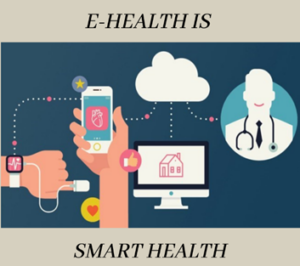Servizi sanitari: i vantaggi del digitale

Il sistema di sanità digitale è un supporto sia per chi presta il servizio sanitario, incrementandone l’efficienza, sia per i fruitori che godono di un accesso più agevole alle cure:
- Accesso migliorato
- Costi ridotti
- Qualità del servizio migliorata
- Terapie personalizzate per i pazienti
I fruitori del servizio possono così gestire e monitorare in modo più efficiente tutti gli aspetti legati alla cura della propria salute.
Sanità digitale: esempi e benefici
Applicazioni per il proprio benessere
Disporre di app mobili dedicate alla salute converte i nostri smartphone in personal trainer, strumenti di monitoraggio del sonno, dispositivi diagnostici e altro ancora, sia per i professionisti che i per i fruitori del servizio.
https://apps.apple.com/us/app/fitness/id1208224953
Apple Fitness+ offre in una sola app pensata per gli utenti di Apple Watch una visione completa della forma fisica dell’utente offre una visione completa della forma fisica di una persona, dagli allenamenti, alle abitudini, ai dettagli dell’attività.
https://apps.apple.com/us/app/apple-health/id1242545199
L’app Health di Apple fornisce un archivio centrale e sicuro per le informazioni sulla salute e il fitness (revisione dei dati relativi alla forma fisica, contapassi, monitoraggio del sonno, promemoria per registrare i farmaci prescritti, conservazione di cartelle cliniche o altre informazioni relative ad allergie, referti di laboratorio, etc., articoli di approfondimento in tema di salute e benessere.)
https://apps.apple.com/us/app/myfitnesspal-calorie-counter/id341232718
MyFitnessPal è un’app per smartphone e un sito web che tiene traccia della dieta e dell’esercizio fisico. L’app è strutturata per incentivare il raggiungimento degli obiettivi di esercizio e dieta.
https://apps.apple.com/us/app/rimidi-patient-application/id1480172513
Rimidi App è progettata per personalizzare la gestione delle condizioni croniche come il diabete, l’insufficienza cardiaca e le malattie cardiovascolari. Può essere associata a glucometri sul mercato per ottenere letture della glicemia e facilitare la condivisione con il professionista.
https://play.google.com/store/apps/details?id=app.medicalid.free&hl=en&gl=US
L’app Medical ID consente di creare profili medici accessibili dalla schermata di blocco di un dispositivo mobile. In caso di emergenza, i profili consentono un accesso rapido a informazioni vitali come allergie, gruppo sanguigno, contatti medici, etc., che risultano essenziali per i primi soccorritori, medici o personale sanitario in procinto di intervenire. Inoltre, l’app può condividere la posizione di una persona con i contatti di emergenza anche quando è chiusa.
Applicazioni ludiche
Questi videogiochi speciali rappresentano una risorsa formativa per professionisti del settore medico e pazienti. Possono anche essere utilizzati da persone interessate a conoscere meglio specifiche malattie.
https://dokiedhuzhqa9.cloudfront.net/
I pazienti guadagnano ricompense assumendo le loro medicine.
https://play.google.com/store/apps/details?id=nl.addapp.hartgame
Indossando i panni di un investigatore medico potrai scoprire le cause dei sintomi di ogni paziente. L’obiettivo è ottenere il punteggio più alto possibile per ciascun paziente.
https://health-iq.scoreapp.com/
Questo strumento diagnostico è utile per capire dove concentrare i tuoi sforzi rispondendo a domande riguardanti il sonno, la salute mentale, la digestione e il fitness. Dopo aver completato il test, riceverai un punteggio generale e un rapporto personalizzato con idee e spunti utili su come migliorare determinate aree riguardanti la salute.
Dispositivi indossabili
Nella gamma dei dispositivi sanitari indossabili è ricompreso l’abbigliamento e altri accessori intelligenti come braccialetti, occhiali e orologi per monitorare e raccogliere informazioni sullo stato di salute dell’utente.
Questi dispositivi sono progettati per monitorare i segni vitali, dal battito cardiaco e la pressione sanguigna al numero di passi fatti e le calorie bruciate. Sono in grado di monitorare la qualità del sonno, tenere traccia dell’aderenza alla terapia, controllare l’esercizio fisico, il conteggio delle calorie, il ritmo cardiaco e i passi effettuati durante la giornata.
Questi dispositivi, indossati al polso dell’utente, sono utili per monitorare la pressione sanguigna a livello clinico e consentono pertanto di assumere decisioni più informate riguardo la dieta e le attività quotidiane, riducendo così il rischio di gravi malattie.
Si tratta in questo caso di piccolo dispostivi per monitorare il livello di glucosio nel sangue, utili per persone che soffrono di diabete. I glucometri sono costituiti da un sensore che, posizionato sull’avambraccio, può inviare dati a un dispositivo di visualizzazione, come uno smartphone o un orologio. Può aiutare le persone con il diabete a gestire i loro livelli di zucchero nel sangue fornendo dati in tempo reale che possono essere utilizzati a fini terapeutici.
Si tratta di un dispositivo che monitora l’attività cardiaca del cuore. Questi dati possono essere utilizzati per diagnosticare aritmie, fibrillazione atriale e insufficienza cardiaca.
